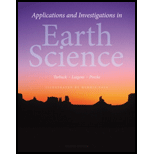Solutions for Applications and Investigations in Earth Science (8th Edition)
Browse All Chapters of This Textbook
Book Details
Note: You are purchasing a standalone product; MasteringGeology does not come packaged with this content. If you would like to purchase both the physical text and My_Lab/Mastering search for ISBN-0321934539. That package includes ISBN-0321934520 and ISBN-0321943422. My_Lab/Mastering is not a self-paced technology and should only be purchased when required by an instructor.
Perfect for use with any Earth Science text, this versatile collection of introductory-level laboratory experiences examines the basic principles and concepts of the Earth sciences. Widely praised for its concise coverage and dynamic illustrations by Dennis Tasa, this full-color laboratory manual contains 23 step-by-step exercises that reinforce major topics in geology, oceanography, meteorology, astronomy, and Earth Science. The new Eighth Edition works with MasteringGeology to improve student preparedness through video and pre-lab assignments and to allow instructors to easily assign and assess student lab performance.
Sample Solutions for this Textbook
We offer sample solutions for Applications and Investigations in Earth Science (8th Edition) homework problems. See examples below:
More Editions of This Book
Corresponding editions of this textbook are also available below:
